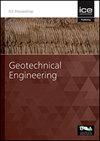堆石料颗粒破碎对路堤坝长期随时间沉降的影响
IF 2
4区 工程技术
Q3 ENGINEERING, GEOLOGICAL
Proceedings of the Institution of Civil Engineers-Geotechnical Engineering
Pub Date : 2022-01-31
DOI:10.1680/jgeen.21.00005
引用次数: 3
摘要
目前的研究是为了监测和恢复Masjed-E-Soleyman, m.e.s.大坝的结构健康,该大坝高177米,是伊朗最高的堆石坝之一。这座大坝受到广泛和不可预测的沉降和相关裂缝的影响。为了研究非均质(砾岩)堆石料在三轴试验前后和试验过程中的脆性行为,采用大型三轴试验装置,在常规应力路径下进行了一系列室内试验。在室内试验中引入了一个随时间变化的数值模型,以寻找颗粒破碎与堤防坝随时间变化的沉降关系。本文的核心是通过建立砾岩材料的相对颗粒破碎指数与塑性功之间的关系,研究砾岩材料在M.E.S.坝中的颗粒破碎情况,修正非均匀相对颗粒破碎指数。本研究的结论分为三个重要步骤。第一步计算破损指数(前后试验)。其次,介绍了断裂指数与塑性功(试验期间)的关系。最后,利用数值粘弹性Burgers模型,给出了坝顶沉降的预测模式,并与M.E.S.大坝的精确监测数据进行了标定。本文章由计算机程序翻译,如有差异,请以英文原文为准。
The Influence of Rockfill Material's Particle Breakage on Long-Term Time-Dependent Settlement of Embankment dams
The current research was implemented to monitor and rehabilitate the structural health of Masjed-E-Soleyman, M.E.S., dam with 177 m height, one of the highest Iranian rockfill dams. This dam suffers from extensive and unpredictable settlements and related cracks. In order to investigate the nonhomogeneous (Conglomerate) rockfill's brittle behavior in Before-After and During the triaxial tests, a series of laboratory tests in conventional stress paths were carried out using a large-scale triaxial apparatus. A numerical time-dependent model was introduced inside the laboratory tests to find a relationship between particle breakage and the time-dependent settlement of the embankment dam. The core of this paper aimed to investigate the particle breakage of Conglomerate material in the M.E.S. dam and to modify the nonhomogeneous relative particle breakage index, by establishing a relationship between relative particle breakage index for this material and the plastic work. The conclusions of this research were categorized into three significant steps. The Breakage Index (Before-After tests) was calculated in the first step. Secondly, a relationship between Breakage Index and plastic work (During tests) was introduced. Finally, a predictable pattern of dam's crest settlement was presented using numerical Viscoelastic Burgers model and its calibration with accurate monitoring data of the M.E.S. dam.
求助全文
通过发布文献求助,成功后即可免费获取论文全文。
去求助
来源期刊
CiteScore
4.40
自引率
4.50%
发文量
68
审稿时长
3 months
期刊介绍:
Geotechnical Engineering provides a forum for the publication of high quality, topical and relevant technical papers covering all aspects of geotechnical research, design, construction and performance. The journal aims to be of interest to those civil, structural or geotechnical engineering practitioners wishing to develop a greater understanding of the influence of geotechnics on the built environment.

 求助内容:
求助内容: 应助结果提醒方式:
应助结果提醒方式:


